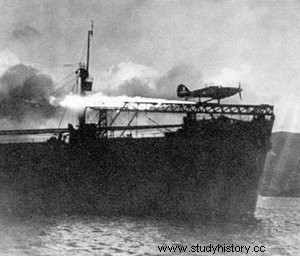
The most effective attempt to defend against the long-range German patrol boats was also the fruit of improvisation. This was to give the convoys instant air cover in the event of an attack. In April 1941, a number of merchant ships had their decks modified to allow the catapulting of a Sea Hurricane (the C.A.M. ships:Catapult Armed Merchantman). In principle, the hunter had to shoot down the bomber, or at least put it to flight, then head for an allied or neutral airfield, if there was one within range. Otherwise the pilot would parachute or land as close as possible to one of the boats, in the hope of being rescued...
The first victory achieved by a catapulted Sea Hurricane was on August 3, 1941, by Lieutenant Robert Everett, of No. 804 Squadron of the Fleet Air Arm, the British naval aviation. He was catapulted from the deck of the ex-8000 ton banana boat HMS Maplin, protecting convoy SL81 en route from Sierra, Leone to England, nearly 700 km off Bordeaux.
"I managed to get closer to 2,500 meters without him seeing me," Everett said when he returned. It had taken me only nine minutes to intercept the Condor and I positioned myself 500 meters parallel to it and a little above. The rear gunner opened fire as I closed in on his right, still a little higher. -ion shot seemed to me too short or too low. It didn't take long to get me into position, and the front gunner of the Focke Wulf started firing too, too short or too low like the other.
The enemy suddenly cleared to the left, then seemed to change their minds and resumed their initial course. I had passed him slightly on the right, and was now under fire from the machine guns and the front cannon. No turn, I made a sharp turn on the blade and opened fire, aiming for the wing root. I fired in successive five-second bursts until I was within 40 yards of the Condor's tail. One last short burst, and my ammunition ran out. I observed metallic debris detaching from the right side, and the interior of the fuselage seemed to me to be on fire. At 30 meters, I pulled out to the left, with my canopy and my windshield covered in oil splashes. I hurriedly jumped out, convinced that the Hurricane's engine oil circuit had been badly damaged. »
In fact - but Everett had no way of knowing - the oil was probably from the Focke Wulf that had been riddled with his bullets. A moment later, the bomber went into a steep dive and crashed into the sea. There were no survivors. The 9,000 liters of gasoline from the Condor left a trail on the surface more than 1,000 meters long and 3 or 4 meters wide.
Some 50 merchant ships were equipped to launch Sea Hurricanes with booster rockets. Several of them were sunk by submarines and most never encountered a Condor and therefore did not have the opportunity to launch their aircraft. In total, the C.A.M. ships destroyed five Focke Wulf 200s, the last on November 1, 1942. But the effect on morale on both sides was far greater than this modest score suggests.
In fact, the real answer to the threat of the Condors as submarines was the convoy escort carrier, a type of vessel which began to emerge from the shipyards in large numbers from September 1941. Three Fw . 200 guarding convoy HG 76 were damaged on December 18 and 19, 1941, and another shot down by fighters launched by the first of these escort carriers, HMS Audacity, which was none other than the former liner German Hannover.
